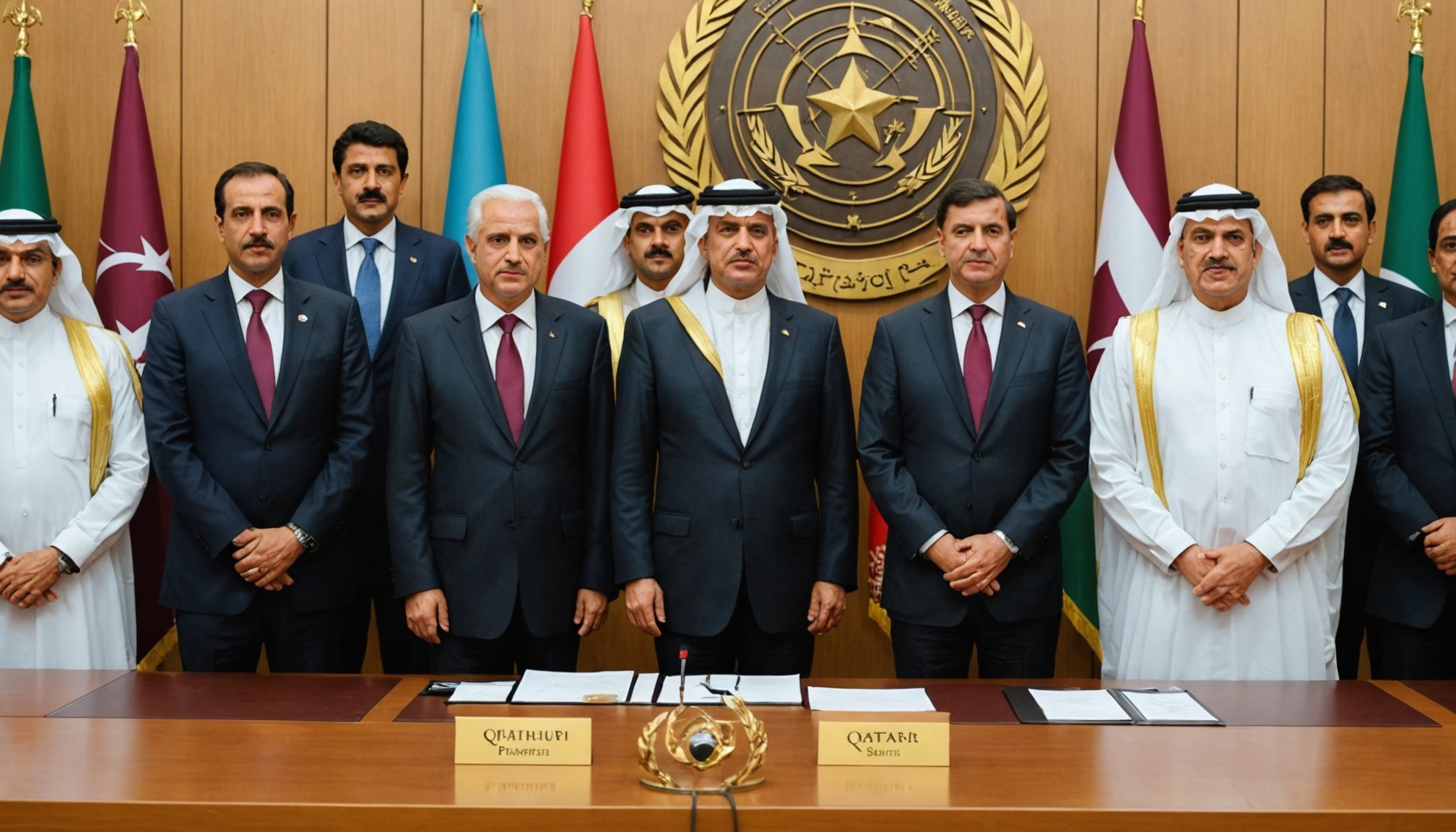In a recent address that has sparked global interest, Qatar’s diplomatic chief unveiled a comprehensive roadmap aimed at fostering global cohesion. This ambitious plan, detailed in a speech at the World Peace Summit, outlines a series of strategic initiatives designed to bridge divides and promote unity across nations. As we delve into the specifics of this roadmap, it’s essential to consider how these proposals might reshape international relations and address some of the world’s most pressing challenges.
The vision for global cohesion
Qatar’s diplomatic chief has long been a proponent of global unity, and the recent roadmap is a testament to this commitment. The vision is clear: to create a world where nations work collaboratively to tackle issues like climate change, economic disparity, and geopolitical tensions. But what does this vision entail in practical terms? Let’s explore the key components of this ambitious plan.
Have you seen this : Essential Tips for Upgrading Cooling Hoses in Your Porsche Boxster to Avoid Overheating
Building bridges through diplomacy
One of the central pillars of the roadmap is the emphasis on diplomacy as a tool for building bridges between nations. The diplomatic chief highlighted several initiatives, including the establishment of new diplomatic channels and the enhancement of existing ones. For instance, the proposal includes the creation of a Global Diplomatic Forum, where representatives from every nation can come together to discuss and resolve conflicts peacefully.
Diplomacy, as outlined in the roadmap, is not just about preventing wars but also about fostering a culture of mutual respect and understanding. An example of this in action is the recent mediation efforts by Qatar in regional conflicts, which have been praised for their effectiveness and impartiality. By promoting dialogue and negotiation, the roadmap aims to reduce the likelihood of escalation and promote lasting peace.
Have you seen this : Unlock the thrill of the player one mystery box experience!
Economic collaboration and shared prosperity
Another crucial aspect of the roadmap is the focus on economic collaboration. The diplomatic chief emphasized that economic interdependence can be a powerful force for global cohesion. By fostering trade agreements and investment partnerships, nations can work together to achieve shared prosperity.
One of the proposed initiatives is the establishment of a Global Economic Alliance, which would facilitate the exchange of goods, services, and knowledge across borders. This alliance aims to level the playing field for developing nations, ensuring they have access to the resources and markets needed to grow their economies. The roadmap also suggests the creation of a fund to support sustainable development projects in underprivileged regions, thereby addressing economic disparities at their root.
Addressing global challenges
The roadmap for global cohesion does not shy away from the world’s most pressing challenges. From climate change to pandemics, the diplomatic chief outlined a series of strategies to tackle these issues head-on. But how can these strategies be implemented effectively? Let’s break down the key areas of focus.
Combatting climate change
Climate change is perhaps the most existential threat facing humanity today, and the roadmap places a significant emphasis on this issue. The diplomatic chief proposed the creation of a Global Climate Action Network, which would bring together scientists, policymakers, and activists to develop and implement climate solutions.
One of the standout initiatives is the commitment to achieving net-zero emissions by 2050. This ambitious goal would require a concerted effort from all nations, but the roadmap suggests several ways to make it happen. For example, it proposes the establishment of a fund to support renewable energy projects in developing countries, ensuring that the transition to a green economy is inclusive and equitable.
Here’s a detailed list of some of the proposed climate action strategies:
- Carbon pricing mechanisms: Implementing a global carbon tax to incentivize the reduction of greenhouse gas emissions.
- Renewable energy investment: Allocating funds to support the development and deployment of renewable energy technologies, particularly in regions with limited access to clean energy.
- Climate education and awareness: Launching global campaigns to educate the public about the impacts of climate change and the actions they can take to mitigate it.
- Resilient infrastructure: Investing in infrastructure that can withstand the impacts of climate change, such as sea walls and flood defenses.
- International cooperation: Strengthening international agreements like the Paris Agreement to ensure that all nations are working together to combat climate change.
Preparing for future pandemics
The recent global health crisis has underscored the need for better preparedness against pandemics. The roadmap includes a comprehensive plan to enhance global health security, with a focus on early detection, rapid response, and equitable access to healthcare resources.
One of the key proposals is the establishment of a Global Health Surveillance System, which would monitor and track infectious diseases in real-time. This system would be supported by a network of laboratories and research institutions, ensuring that any new outbreaks can be quickly identified and contained.
The roadmap also emphasizes the importance of vaccine equity, proposing the creation of a fund to support the development and distribution of vaccines to low-income countries. By ensuring that all nations have access to life-saving treatments, the plan aims to prevent the kind of disparities seen during the COVID-19 pandemic.
Insights from experts and leaders
The roadmap for global cohesion has garnered significant attention from experts and world leaders, many of whom have praised its ambitious goals and practical approach. Here are a few insights from those who have weighed in on the proposal:
“Qatar’s roadmap is a bold and necessary step towards a more cohesive and peaceful world. By focusing on diplomacy, economic collaboration, and global challenges, it addresses the root causes of many of our current problems.” – Dr. Jane Goodall, environmentalist and UN Messenger of Peace.
“The emphasis on climate action and health security is particularly commendable. These are issues that require global cooperation, and the roadmap provides a clear path forward.” – Dr. Tedros Adhanom Ghebreyesus, Director-General of the World Health Organization.
“Economic collaboration is the key to shared prosperity. The proposed Global Economic Alliance could be a game-changer for developing nations, providing them with the resources they need to grow and thrive.” – Kristalina Georgieva, Managing Director of the International Monetary Fund.
Comparative analysis of global initiatives
To better understand the significance of Qatar’s roadmap, it’s helpful to compare it with other global initiatives aimed at fostering cohesion and addressing global challenges. The table below provides a comparative analysis of three such initiatives:
| Initiative | Focus Areas | Key Strategies | Notable Achievements |
|---|---|---|---|
| Qatar’s Roadmap for Global Cohesion | Diplomacy, Economic Collaboration, Climate Change, Health Security | Global Diplomatic Forum, Global Economic Alliance, Climate Action Network, Health Surveillance System | Proposed comprehensive plan with broad support from experts and leaders |
| United Nations Sustainable Development Goals (SDGs) | Poverty, Inequality, Climate Change, Peace and Justice | 17 Goals with specific targets and indicators | Global framework adopted by all UN member states, driving action on multiple fronts |
| Paris Agreement | Climate Change | Commitments to reduce greenhouse gas emissions, Adaptation measures | Nearly universal participation, with significant progress in renewable energy adoption |
Practical steps for individuals and communities
While the roadmap for global cohesion is primarily aimed at governments and international organizations, there are practical steps that individuals and communities can take to contribute to its goals. Here are some actionable tips:
Engage in local diplomacy: Participate in community dialogues and peace-building initiatives. By fostering understanding and cooperation at the local level, you can help build a foundation for global cohesion.
Support sustainable practices: Make conscious choices to reduce your carbon footprint, such as using public transportation, reducing waste, and supporting renewable energy projects. These actions can contribute to the broader goal of combating climate change.
Advocate for health equity: Support organizations that work to improve access to healthcare in underserved communities. Whether through donations or volunteering, you can help ensure that everyone has the resources they need to stay healthy.
Stay informed and engaged: Keep up with global issues and participate in discussions about how to address them. By staying informed, you can advocate for policies and initiatives that align with the goals of the roadmap.
Conclusion: A path forward
Qatar’s diplomatic chief has laid out a visionary roadmap for global cohesion that addresses some of the most pressing challenges facing our world today. From diplomacy and economic collaboration to climate action and health security, the plan offers a comprehensive approach to building a more united and prosperous future.
As we move forward, it’s crucial that nations, organizations, and individuals alike take up the mantle of this roadmap. By working together and taking concrete actions, we can turn this vision into a reality. So, what role will you play in shaping a more cohesive global community? The journey starts now.











